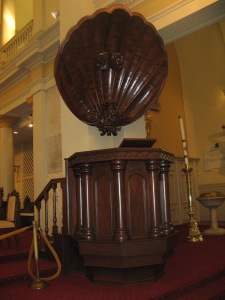On the 18th and 19th we visited the Cabildo, the St. Louis Cathedral and the 1850 House, all connected in a surround which makes up one end and one side of Jackson Square in the European manner of government. Even small villages in France and Spain were set up in this manner. The church, the offices of government, the communal well, the market, all centrally and efficiently located for people to gather and do business.
The St. Louis Cathedral is the oldest Catholic Church in the United States. Built in 1717, replaced, burned down and the final Cathedral stands on the same spot. The Ursuline Convent, nearby, is believed to be the oldest French building still standing in the Mississippi Valley. Interesting that the Ursulines and Jesuits both had slaves during the Antibellum years. Then later, they took in children of slaves and did many good works. Politics and religion were closely entwined making me grateful our constitutional fathers had the wisdom to separate Church and State.
This beautiful carved wooden hand, fronted by a mothers beautiful face, held the head of the baby to be baptized.
The carved wooden pulpit is also a beautiful work of art as are the stained glass windows that line both sides of the church. Beautiful old world type frescoes cover the ceiling. A must see if you get to New Orleans.
The Cabildo, which is the Spanish word for Government Council, is one of the most comprehensive, thorough and easy to understand museums I've ever visited. Louisiana typically does a great job on their museums and keeps the prices affordable as well. Not all of them have the whirlwind Jimmy Jackson at their service, however. Jimmy gives you the best tour, suggests places to eat to suit your taste (if asked) and made our museum tour extra relevant.
Its tough to give a true feel for the place. It takes you from the early Indians, through the War of 1812, the Civil War and reconstruction. Added to that was a modern Rock and Roll exhibit and a gallery of the years best pictures of 2009 culled to 85 from 55,0000 submitted. I was impressed by the fact that the Indians here so outnumbered the settlers, both French and Spanish, that they could compete with the intruders. They held tightly to the secrets of their medicinal herbs and bartered using the knowledge of food plants, the land, the swamps, and weather. All the settlers failed at growing wheat and embraced the local food of the Indians. Only later did they turn to rice and sugar and tobacco. The photo above is playing cards used in place of hard currency. Readily available, one card equaled about 12 cents.
And, as always, appalled at man's inhumanity to man. Above is a slave collar with bells. They would fill the bells with mud to hide their movements. The slaves, despite their servitude, managed as best they could, some sense of community and family. That is here too. In fact, the records indicate that more slaves and free people of color attended church, were baptized, married and participated than the settlers.
The Louisiana purchase, signing the papers for transfer from the Spain, to France to the United State is covered fully here. The papers were signed in this building. The Battle of New Orleans is also comprehensively covered. Don't miss this museum when you visit. The picture above is one of thousands of bottles used to mark the borders of the Louisiana Purchase. Survey notes were sealed inside and the bottles were buried in huge heaps to mark their spot. Not all of them were recovered and could still be out there waiting for somebody to find.







No comments:
Post a Comment